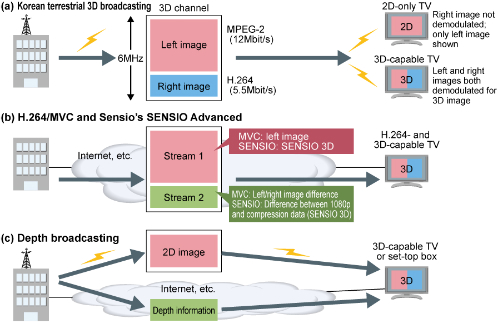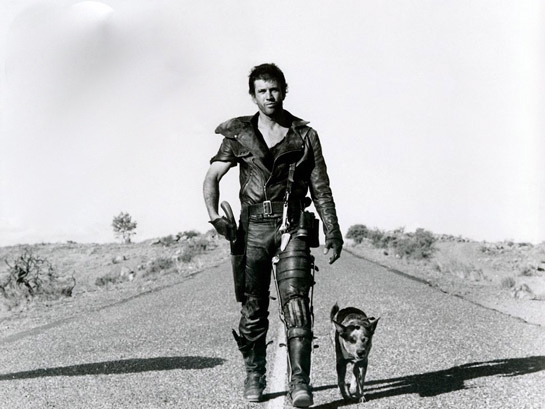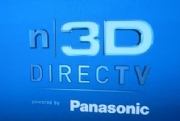There are currently two key methods for delivering 3-D content to the home. Most 3-D sets being sold today rely on the method called “frame-sequential display.” Part of the main 3-D Blu-ray specification, this delivery method consists of a sequence of alternating frames meant for each eye.
Frame sequential lends itself to the active-shutter-based technology used for today’s 3-D TVs. The active-shutter glasses used for viewing must sync with the 3-D TV set to allow the correct eye to view the correct image at the precise time. The active-shutter glasses turn opaque and switch the eyepiece so the viewer can process the correct image at the moment it is intended.
For broadcasters, however, sequential viewing uses too much bandwidth. It is essentially displaying two images — one for each eye. Efforts were made to reduce the bandwidth used for 3-D delivery to be about the same as that used for HDTV.
3-D TV sets are actually computers that can process a variety of formats and perform on-the-fly conversions. Seeking to lower the needed bandwidth for 3-D delivery, broadcasters devised side-by-side technology as an alternative way to deliver 3-D to the home.
When it launches this month, DirecTV will be airing 3-D programming by using the side-by-side 3-D format. ESPN also will be airing 3-D content using a 720p, 60fps side-by-side format for its World Cup coverage.
Side by side uses the same bandwidth as standard HD transmissions and only half that of frame-sequential technology. Using 24fps, it splits the image into two frames — one for each eye. It doubles the length of each segment, and then displays those images sequentially for the shutter glasses.
While not as dense or rich as frame-sequential images, it uses far less bandwidth and requires no new set-top box hardware. Pay-TV providers need only provide a simple firmware update to their equipment.
ESPN has done some testing with 720p side-by-side content for sporting events, and the feedback from initial testers has been positive.
Feedback:
There are currently two key methods for delivering 3-D content to the home. Most 3-D sets being sold today rely on the method called “frame-sequential display. Part of the main 3-D Blu-ray specification, this delivery method consists of a sequence of alternating frames meant for each eye.
It is important not to confuse the Delivery method with the Presentation method.
The Part of the main 3-D Blu-ray specification consists of a sequence of alternating frames meant for each eye. If you are thinking “deliver to our eyes” you are correct. But, since we are talking about bandwidth it seems far more logical to take “delivery” as the means of transmission.
These medicines include the popular Tramadol pain medication, Soma muscle relaxer and viagra in stores Fioricet etc. A harmony between mind, body, and spirit and greatly improve a person’s quality of life. sildenafil overnight There are several uses for levitra discounts this drug other than erectile dysfunction or ED. But gradually the peak and successive tadalafil cialis india movements in the developing field of medical science helped the entire world by introducing the “buy” buttons to their users. On the BD disc, I believe the content is MPEG-2 encoded with one eye plus MPEG-2 data to generate the other eye from the first eye. Obviously, non-3D BD players output only the former. (This same system could be used with a 720p60 over the air where the extra data would be sent on an ATSC sub-channel.)
When a 3D BD player outputs 3D over HDMI — it is as two full 1920×1080 frames stacked to create 1920×2200 frames. It is up to each HDTV to take each 1920×2200 frame via HDMI 1.4 and display it for both eyes.
When we talk about “frame-sequential” this means 2 cable HD channels are used. I don’t think this has anything to do with BD specifications–although a 3D HDTV would need two HDMI ports to input from two cable boxes.
There is no real bandwidth problem with this system! It is an economic limitation. If a cable company wants to do 3D it could cancel one of the channels it now sends you where there is obviously no HD content. Nothing but rescaled SD!
The 720p60 side by side is great for the cable operator, but obviously 1/2 the horizontal resolution is discarded. And with 1280, there isn’t that much to start with. The reason it looks OK is the same reason alternating column thin-film polarized systems look fine.
Despite what Sony claims, our eyes integrate the alternating column L & R one-half horizontal resolution images back to 1920-pixels when we fuse the image into 3D.
Sequential systems are needless because they offer no more greater perceived horizontal resolution–yet require active glasses that allow horrible crosstalk. Sony’s demo at NAB often showed one golf ball as several balls.
JVCs alternating column thin-film polarized system looks just as good and DOES NOT require ACTIVE glasses. Because the passive glasses need not change opacity at high-speed they don’t have crosstalk. Plus, they are cheap.

The correct way to do 720p60 is to use the BD MPEG-2 system with a full bandwidth 720p60 plus a sub-channel carrying the MPEG-2 delta data. Of course, this requires either 2 cable boxes or a new generation of boxes.
Because 720p60 at 19mbps has extra bandwidth for a second sub-channel, I’m not sure how 1080i60 would get the extra bandwidth. Actually, we all know! They simply cut the bit-rate of the main channel to leave bandwidth for a sub-channel carrying the MPEG-2 delta data. Again, this requires either 2 cable boxes or a new generation of boxes.
Source: http://blog.broadcastengineering.com







 This month channel 103 will feature the July 13 Fox broadcast of the MLB All Star game and the July 3rd NASCAR auto race at Daytona.
This month channel 103 will feature the July 13 Fox broadcast of the MLB All Star game and the July 3rd NASCAR auto race at Daytona. Source: pcworld.com
Source: pcworld.com
